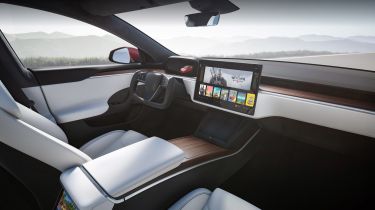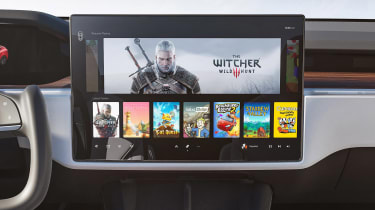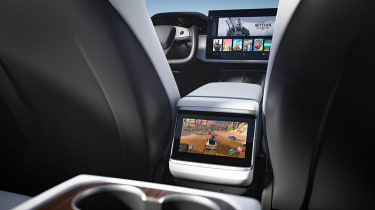Tesla Model S hatchback - Interior & comfort
The Model S’ tech-filled interior is let down by some cheap-feeling trim
With many examples costing more than £100,000, you’d expect the Tesla Model S to feel suitably luxurious inside, and this is true – to an extent. The jet-fighter-style ‘yoke’ steering wheel adds a sense of occasion (a standard, round steering wheel is also available) while the overall design of the cockpit is modern and minimalist.
The Model S’ cabin comes wrapped in leather as standard – buyers have a choice of black, white or cream upholstery – however, there are several pieces of cheap plastic scattered around that are not befitting of the car’s lofty price tag. Build quality is also a concern; while this has certainly improved in recent years, Teslas have been known to be full of ill-fitting trim pieces, leaving large panel gaps and unwanted rattles and squeaks.
Tesla Model S infotainment and navigation
Dominating the centre of the dashboard is the Model S’ expansive 17-inch touchscreen infotainment system. This is among the best in the business and is as responsive to your touch as the top smartphones. While features such as sat-nav come as standard, the touchscreen functions more as a tablet than an in-car information display; as well as providing useful car-related info, Tesla’s infotainment system features built-in video games and apps such as Netflix, so you can watch a movie whilst you are parked up or charging your car.
The touchscreen is further bolstered by another display, sitting behind the steering wheel. Like most digital instrument clusters, this provides relevant information such as the current speed and can even display sat-nav directions, negating the need for the driver to take their eyes off the road. There’s also another touchscreen on the back of the centre console, exclusively for back seat passengers; like the one in the front, this is also loaded to the brim with games and features.
More reviews
In-depth reviews
Unfortunately, this reliance on screens means performing certain tasks in the Model S can be more complex and fiddly than they need to be. For example, to maintain the car’s minimalist interior, there is no lever to open the glovebox – this must be done by delving into a sub-menu in the screen. There are no physical buttons on the steering wheel, either; the touch-sensitive controls can be finicky at times and aren’t as straightforward to operate as a simple toggle or switch.
Equipment
As standard, the Model S comes absolutely loaded with equipment. Highlights include satellite navigation with seven years of updates, power-adjustable heated leather seats, a wireless phone charging pad, a tinted glass roof and a 360-degree camera system.
Matching the novelty of the Tesla’s performance, the climate-control system’s outlandishly named 'Bio-Weapon Defence Mode'; this enables an extremely capable HEPA air filtration system that's claimed to remove over 99.7% of all allergens and bacteria from the air inside the car.
Many of the car’s features are continually updated using the internet connection. Because so much of the Tesla is controlled by software, rather than physical components, the possibilities for wireless upgrades are many and varied.
Options
Given its already-high specification, there are very few optional extras available to Model S buyers. Metallic paint can range from a few hundred pounds to multiple thousands for the striking Red Multi-Coat shade, while 21-inch alloys can also be specified.
Perhaps the most significant option available is the ‘Advanced Autopilot’ and ‘Full Self-Driving Capability’ packs. Do not be fooled by the names, however; while both offer varying levels of driver assistance features and semi-autonomous driving capabilities, even the ‘Full Self-Driving’ pack requires full attention from and occasional input from the driver.














